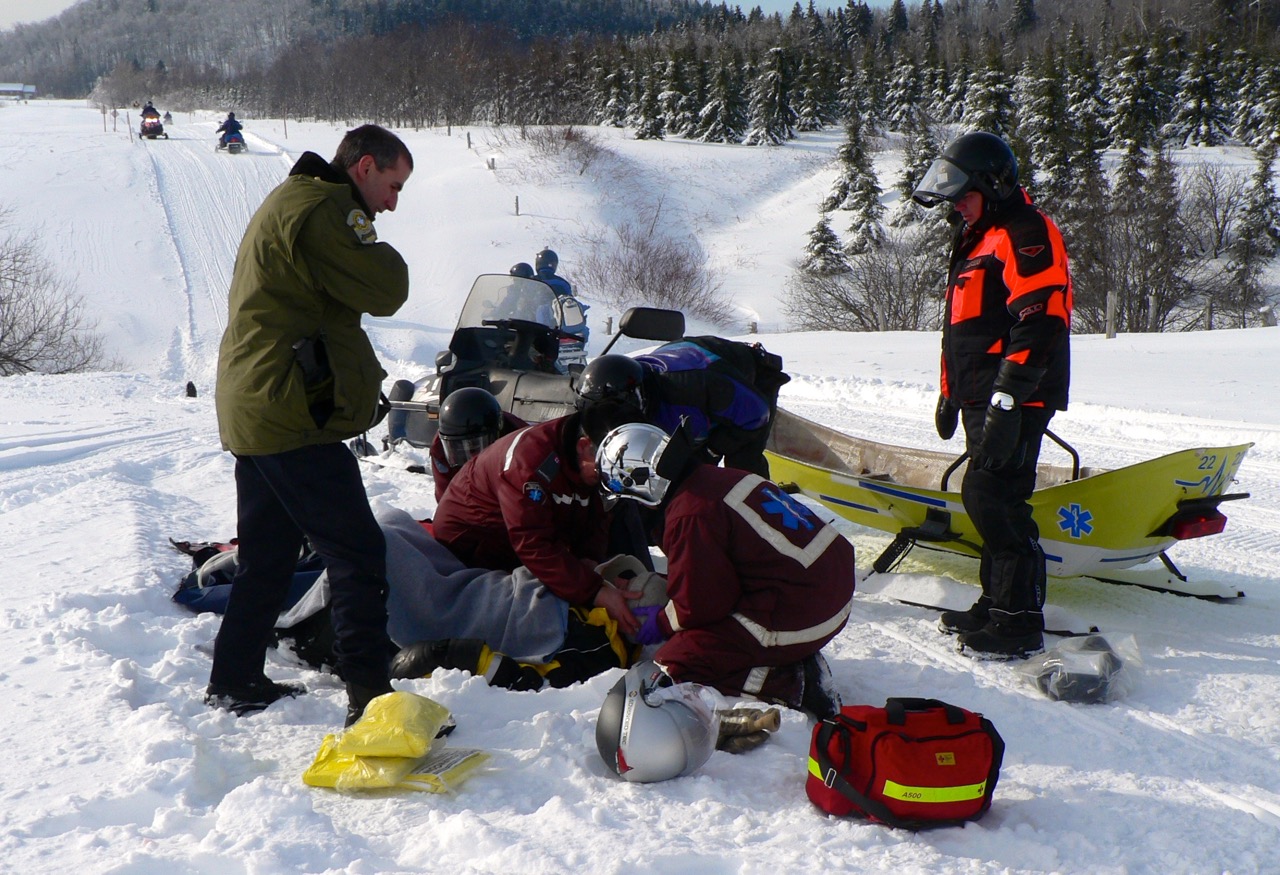Cold First Aid Facts About On Trail Injuries…

Photo © by Craig Nicholson
Related: 5 Life Saving Survival Tips
What are the first aid realities on snowmobile tours? Given the millions of miles North American snowmobilers rack up each winter on their snowmobile vacations, fortunately, we don’t need that snowmobile safety answer very often. Surprising really, when you think of all that remote riding area and those thousands of riders. To say nothing of variable snow conditions and all the potential accidents just waiting to happen.
If an incident does occur in the middle of nowhere involving bodily harm or medical emergency, a snowmobile medivac may be your only lifeline. Unfortunately, if one is even available, it likely won’t be quick or convenient. And the victim may require serious first aid assistance in the meantime. So that’s why I decided to get some training. But I’m not encouraged by what I learned…
After taking first aid training for snowmobiling, I told my wife we were screwed. The only confidence I gained for handling snowmobile medivac injuries was the certainty that I’d do more harm than good if it ever came to that!
First Aid Starts with 911
The first aid program procedures start with the words, “Call 911 and then…” Even if I had cell service, how am I supposed to give directions? And who knows if if the emergency folks could get there fast enough anyway, if at all.
Then I was concerned about the liability question. Sure, as Facebook follower Scott Patterson pointed out to me, many jurisdictions have Good Samaritan legislation. It protects the first aider, but the instructor stressed that the first thing to do is to tell the injured person: “I know first aid”. And then ask their permission to help, preferably with a witness. What scares me is the possibility that the injured party will say “yes”, imagining I have every qualification except a medical degree. When in fact, I may know only slightly more than the nearest tree.
Many First Aid Quandaries
If the victim says “no”, I wondered, do I breathe a sigh of relief and watch them morph into a Popsicle? One is never supposed to leave anyone alone. But what if there are only two of us and no cell service? Moving a person with undetermined injuries isn’t recommended either. Am I more likely to be sued for leaving the victim to get help? Or for risking greater injury by riding the person out on my sled?
The course also recommended opening and loosening the victim’s clothing for greater comfort. I’m not sure my injured buddy would be more comfortable with his heat escaping and the cold coming in faster! On the other hand, I may have to remove clothing to assess and deal with injuries. So how do I keep an injured snowmobiler warm?
I learned not to move victims with possible head, neck or spine injuries, all common in snowmachine collisions. If the person is not breathing, then mouth-to-mouth resuscitation is necessary. Of course, this action assumes no helmets in the way, especially full-face ones. So now I have the liability risk of deciding between removing a helmet to give mouth to mouth, and possibly aggravating a neck injury. Or not being able to accomplish resuscitation. To say nothing of having to take off my own helmet and lose 35% of my own precious body heat!
What’s With First Aid CPR?
If artificial resuscitation doesn’t work, I’m supposed to start CPR. This process requires the opening and loosening of the victim’s clothing for chest access, so on the snow, CPR becomes a race against hypothermia. And not just for the exposed victim…
I worked up a good sweat doing vigorous training CPR on a dummy. So how do I stay dry and ward off hypothermia on the snow? I figure there’s a 100% chance of my being soaked while trying to save someone through CPR.
Then the kicker. I also learned that CPR only succeeds about 3% of the time! Now I’m picturing myself in the freezing cold, with 100% chance of getting hypothermia. Versus a 3% chance of saving someone whose family may sue me anyway. And let’s not forget that once started, I’m supposed to continue CPR until relieved by an ambulance carrying something similar to the Philips Heartstart device and heartstart onsite FRx battery. Hopefully, that will work. It can be quite scary giving someone CPR, especially when you’re not 100% sure about how to do it.
My Last Word
So first aid is still a quandary to me. But I’m sure of one thing. It’s much easier to ride safely. Also, to wear a TekVest and avoid collision, than it is to deal with any resulting injuries. And then I’ll never have to worry about providing first aid! However, if worst comes to worst, you need a good emergency kit on board. I’d also suggest a signalling beacon like SPOT X or a Globalstar Satellite phone to get assistance as quickly as possible.
Speaking of help and 911, here’s a tip for anyone riding in Quebec. Apparently, their first aid realities include large areas that are not served by 911 emergency service. This means that snowmobilers can’t always count on quick medical assistance and air transport in times of need. So, I suggest signing up for inexpensive protection from Airmedic. For as little as $30 for ten days, residents and non-residents alike can buy peace of mind. And that comes in the form of the most rapid deployment of help available when things go tragically wrong!
Like This Post? Follow Me on Facebook!
The tips and advice in this blog are the opinions of the author, may not work in every situation and are intended only for the convenience and interest of the reader, who has the personal responsibility to confirm the validity, accuracy and relevancy of this information prior to putting it to their own use.
